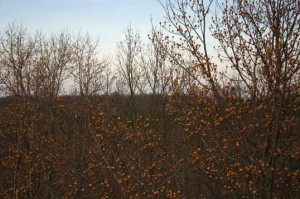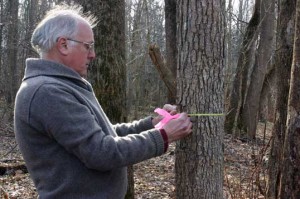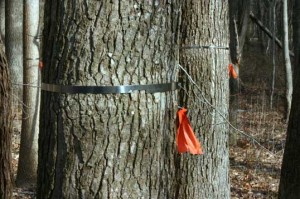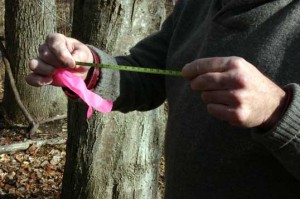by Tina Tennessen

Liriodendron tulipifera, or tulip poplar, is a common tree in the temperate forests surrounding the Smithsonian Environmental Research Center. Other species include sweetgum, American beech, and southern red oak. Photo: Kirsten Bauer.
For more than 20 years forest ecologist Geoffrey Parker has tracked the growth of 55 stands of mixed hardwood forest plots in Maryland. The plots range in size, and some are as large as 2 acres. Parker’s research is based at the Smithsonian Environmental Research Center, 26 miles east of the nation’s capital.
Parker’s tree censuses have revealed that the forest is packing on weight at a much faster rate than expected. He and Smithsonian Tropical Research Institute postdoctoral fellow Sean McMahon discovered that, on average, the forest is growing an additional 2 tons per acre annually. That is the equivalent of a tree with a diameter of 2 feet sprouting up over a year.

Forest ecologist Jess Parker began his tree censuses his first day on the job: September 8, 1987. Photo: Kirsten Bauer.
Forests and their soils store the majority of the Earth’s terrestrial carbon stock. Small changes in their growth rate can have significant ramifications in weather patterns, nutrient cycles, climate change and biodiversity. Exactly how these systems will be affected remains to be studied.
Parker and McMahon’s paper focuses on the drivers of the accelerated tree growth. The chief culprit appears to be climate change, more specifically, the rising levels of atmospheric CO2, higher temperatures and longer growing seasons.
Assessing how a forest is changing is no easy task. Forest ecologists know that the trees they study will most likely outlive them. One way they compensate for this is by creating a “chronosequence”—a series of forests plots of the same type that are at different developmental stages. At SERC, Parker meticulously tracks the growth of trees in stands that range from 5 to 225 years old. This allowed Parker and McMahon to verify that there was accelerated growth in forest stands young and old. More than 90% of the stands grew two to four times faster than predicted from the baseline chronosequence.

Parker, his colleagues and a team of citizen scientists have tagged more than 20,000 trees at the Smithsonian Environmental Research Center. Photo: Kirsten Bauer.
By grouping the forest stands by age, McMahon and Parker were also able to determine that the faster growth is a recent phenomenon. If the forest stands had been growing this quickly their entire lives, they would be much larger than they are.
Parker estimates that among himself, his colleague Dawn Miller and a cadre of citizen scientists, they have taken a quarter of a million measurements over the years. Parker began his tree census work Sept. 8, 1987—his first day on the job. He measures all trees that are 2 centimeters or more in diameter. He also identifies the species, marks the tree’s coordinates and notes if it is dead or alive.
By knowing the species and diameter, McMahon is able to calculate the biomass of a tree. He specializes in the data-analysis side of forest ecology. “Walking in the woods helps, but so does looking at the numbers,” said McMahon. He analyzed Parker’s tree censuses but was hungry for more data.

Parker uses diameter tape or 'd-tape' to measure the trees. The tape is calibrated to convert the tree’s circumference, the measurement used to determine a tree’s biomass. Photo: Kirsten Bauer.
It was not enough to document the faster growth rate; Parker and McMahon wanted to know why it might be happening. “We made a list of reasons these forests could be growing faster and then ruled half of them out,” said Parker. The ones that remained included increased temperature, a longer growing season and increased levels of atmospheric CO2.
During the past 22 years CO2 levels at SERC have risen 12%, the mean temperature has increased by nearly three-tenths of a degree and the growing season has lengthened by 7.8 days. The trees now have more CO2 and an extra week to put on weight. Parker and McMahon suggest that a combination of these three factors has caused the forest’s accelerated biomass gain.
Ecosystem responses are one of the major uncertainties in predicting the effects of climate change. Parker thinks there is every reason to believe his study sites are representative of the Eastern deciduous forest, the regional ecosystem that surrounds many of the population centers on the East Coast. He and McMahon hope other forest ecologists will examine data from their own tree censuses to help determine how widespread the phenomenon is.
These findings are also important for policymakers trying to address climate change. Future carbon cap-and-trade rules will need to quantify the amount of carbon forests hold. If faster growth rates prove the norm, this could affect the formulas and the dollar value assigned to forests that are cut or conserved.
Parker and McMahon don’t expect SERC’s forest to continue growing at this accelerated rate forever. Some day the growth rate will level off. When that happens, they wonder how that will affect CO2 levels. If trees are sponges that absorb CO2, what will happen to CO2 levels in the atmosphere when the trees become saturated? It’s a question for further exploration. In the meantime, Parker will continue walking through the SERC woods, tape measure in hand carefully tracking the growth of the trees.
The study is available online at PNAS.org .
Listen to WNYC radio host Leonard Lopate’s interview with Geoffrey Parker.


very interesting paper. How much co2 does 1.8 tons of timber represent? Do the same growth parameters extend to other plants? Is this one of nature’s natural response to increased co2 and thus helping to bring it under control? regards Bill
Very interesting work. I have not been able to access the paper yet but I assume you have controlled for the availability of soil moisture and have ruled that out. Have you compared your forest growth rate data with comparable data from the U.S. Forest Service FIA data from recent inventories. My recollection from having looked at the FIA data for Maine is that forest growth rates declined from the inventories of 1959 and 1972 to the inventories of 1982 and 1995. Net annual growth increased from 1995 to the present, but rates during 2004 through 2008 were lower than determined for the 1959 and 1972 inventories. Refs: http://www.maine.gov/doc/mfs/pubs/htm/supply.htm http://199.128.173.17/fiadb4-downloads/ME.pdf
Yes, PNAS will make the paper available online sometime this week – we just don’t know when, exactly. Thanks for your interest.
“climate change appears to driving accelerated growth” ???
This could be called a “natural response”. It is actually called Photosynthesis: light + Carbon dioxide + water = glucose + oxygen. If one increases any necessary component of photosynthesis a greater bi-product will be the result. That is an imperical truth. Anthropogenic global warming is the greatest fairy tale in history.
Since when did we moderate the truth?
“Parker and McMahon don’t expect SERC’s forest to continue growing at this accelerated rate forever. Some day the growth rate will level off.”
Wouldn’t seedlings also increase and grow faster, too? In other words, the only thing that would “level off” the growth would be a limit to the area it is allowed to cover until that area is saturated. Even so, if all plants are exhibiting growth rates of some level, isn’t this a good thing for all of us? At least those of us who obtain a level of food source from the planet’s plant life, anyway. These plants aren’t “doing us a favor” by sequestering CO2, they are, literally “eating it up”.
“More than 90% of the stands grew two to four times faster than predicted”. This is huge!
And let us all remember that food plants also grow three times faster. Thank you carbon dioxide! Now, why would governments want to decrease CO2 emissions?
Here is the paper, which is surprisingly less informative than this blog post :
http://www.pnas.org/content/early/2010/02/02/0912376107.full.pdf
I have been able to have access to the paper, I guess its online now.
Cheers,
I seem to remember that the growth rates of bristle cone pine in the SW US, measured by dendrochronology, were used to study historic rainfall patterns. Also,there could be other factors responsible, e.g. increased nutrients.acid rain, etc.
I am NOT a scientist – but I love reading about all of this. Thank you!
No matter how much carbon Americans burn, the faster forest growth they witness here will never compensate for the amount of good lumber wasted in the crumbling of Detroit City! Huge mansions filled with the tress of the West Coast, burnt at night for political Hellery! Shame America! Shame! Replacements for the resources you willfully waste cannot possibly grow fast enough to replace the damage you do! You have squandered the world’s oil in V-8 engines just to hear them roar, and Your own politicians are telling you the economic end to your folly in near, yet you still allow wanton destruction in your country! Shame!
I have also noticed the accelerated growth of trees even within my own neighborhood. I am concerned however that this may be short-lived. The amount of carbon dioxide generated is at a run-away pace and the trees will not be able to compensate completely for this increase. Consequently, I foresee the precipitation becoming more acidic due to the carbon dioxide. This in turn could cause leaching of important nutrients away from tree roots causing them to weaken and die. My point in this is that we still need to reverse our carbon dioxide output and find additional ways to put the carbon dioxide in a carbon sink.
Dear Linda,
We believe that the recent increase in growth of forests in the region of the Smithsonian Environmental Research Center (SERC) is not likely continue indefinitely – trees will probably encounter other limitations such as the availability of water or nutrients. As the current growth spurt is likely reducing the climbing rate of atmospheric carbon dioxide we would expect that increase would accelerate when the period of extra growth ends. As to the effect of extra CO2 on the acidity of precipitation, carbonic acid is much weaker than the dominant acids of acid rain (sulfuric and nitric). I expect that in industrialized areas the extra acidity from increased CO2 emissions won’t have much effect on pH. However this could be a problem in cleaner regions where rainfall acidity is dominated by carbonic and other weak organic acids.
Thanks for your comment,
Geoffrey Parker
Forest Ecologist
Smithsonian Environmental Research Center
Manny, to say that faster growth from high CO2 rates is good for trees is about as clever as saying faster weight gain from eating extra calories is good for humans.
How’s that McDonald’s working out for Americans afflicted with epidemics of heart disease and diabetes?
“Forests and their soils store the majority of the Earth’s terrestrial carbon stock” what does it means ?
Great article. I agree I would love to know how much CO2 1.8 of timber creates. Very interesting how this affects the climate.
That was a great read. I never thought about the rise in CO2 affecting the growth rate of plant life. Perhaps this will assist with balancing the levels in the atmosphere.
Well isn’t that exactly the reason why they are growing so quickly? If the climate produces more CO2 I would expect from your analysis that the timber would become stronger and continue to grow at above average rates. Very neat article Tina.
I live in the tropical climate, where forests are still a lot, but the weather is changing so fast. actually what is happening with the world today
I was looking for somethink like that, i write a text for my school about Geoffrey Parker thank’s for this info.
The forests are the greatest asset to the people and therefore the people across the world have been quite keen to know more about it.
With large areas of the Amazon forests being lost each year, it is heartwarming to learn that in some parts of the world rising levels of CO2 are prompting increased tree growth. A ray of sunshine in an otherwise gloomy world.
Scientists have known for years that long-term solar variations affect certain weather patterns, including droughts and regional temperatures.
But establishing a physical connection between the decadal solar cycle, global climate patterns and accelerated growth of trees is pretty amazing. As other have already mentioned I also believe the rapid growth will be short-lived not just from the increase CO2 levels but also from lack of rain fall as we’re already experiencing not only here in the states but also across the world.
Did you know …
Two mature trees produce enough oxygen for a person to breathe for an entire year?
Best,
steve
I have to agree with Tony above – however there must surely come a tipping point where less and less trees are absorbing more and more CO2?
I like the helpful information you provide in your articles.
I’ll bookmark your weblog and check again here regularly. I’m quite certain I’ll learn lots of new stuff right here! Best of luck for the next!
Best Regards Cassetta
Nice information,… thanks
Regards,
Sofian
This information is very important for people like myself who love nature. Trees have been proven to possess energy. They respond to stimuli and show different energetic changes similar to humans.
That you for the article…
I found it very interesting and supportive to the idea that Earth do fight back. For example, looking at past documentaries such as ‘how to grow a planet’, like when green started appearing to flowers/fruits evolution to entice reproduction, one can see evolution still taking place today…
Yet, just like plants, trees… we have also to grow and change to support Earth’s life, including ourselves.
Its amazing how Earth can manage and try to balance itself when we Human Beings cannot… In many ways, Earth has more brains :-)
Thank you
These varied consequences as a result of climate change highlight the need for adequate forest management strategies. Quite complicated.
Coverts Blog . Shorelines with extensive, mature forests along the shore are critical yet rare habitats in New Hampshire. Native shrubs and trees growing along shorelines help protect the water from soil erosion, runoff, pesticides, chemicals, and excess nutrients.